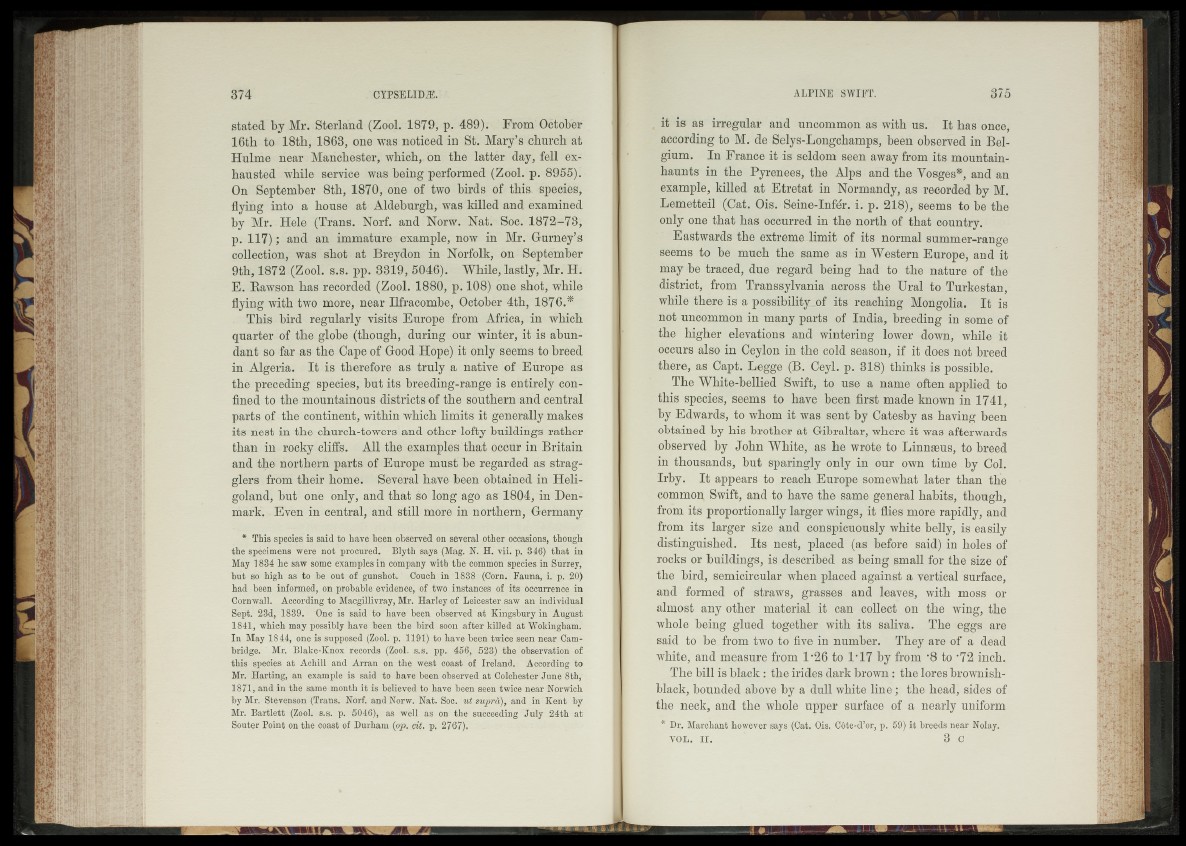
stated by Mr. Sterland (Zool. 1879, p. 489). From October
16th to 18th, 1863, one was noticed in St. Mary’s church at
Hulme near Manchester, which, on the latter day, fell exhausted
while service was being performed (Zool. p. 8955).
On September 8th, 1870, one of two birds of this species,
flying into a house at Aldeburgh, was killed and examined
by Mr. Hele (Trans. Norf. and Norw. Nat. Soe. 1872-73,
p. 117); and an immature example, now in Mr. Gurney’s
collection, was shot at Breydon in Norfolk, on September
9th, 1872 (Zool. s.s. pp. 3319, 5046). While, lastly, Mr. H.
E. Bawson has recorded (Zool. 1880, p. 108) one shot, while
flying with two more, near Ilfracombe, October 4th, 1876.*
This bird regularly visits Europe from Africa, in which
quarter of the globe (though, during our winter, it is abundant
so far as the Cape of Good Hope) it only seems to breed
in Algeria. It is therefore as truly a native of Europe as
the preceding species, but its breeding-range is entirely confined
to the mountainous districts of the southern and central
parts of the continent, within which limits it generally makes
its nest in the church-towers and other lofty buildings rather
than in rocky cliffs. All the examples that occur in Britain
and the northern parts of Europe must be regarded as stragglers
from their home. Several have been obtained in Heligoland,
but one only, and that so long ago as 1804, in Denmark.
Even in central, and still more in northern, Germany
* This species is said to have been observed on several other occasions, though
the specimens were not procured. Blyth says (Mag. N. H. vii. p. 346) that in
May 1834 he saw some examples in company with the common species in Surrey,
but so high as to be out of gunshot. Couch in 1838 (Corn. Fauna, i. p. 20)
had been informed, on probable evidence, of two instances of its occurrence in
Cornwall. According to Macgillivray, Mr. Harley of Leicester saw an individual
Sept. 23d, 1839. One is said to have been observed at Kingsbury in August
1841, which may possibly have been the bird soon after hilled at Wokingham.
In May 1844, one is supposed (Zool. p. 1191) to have been twice seen near Cambridge.
Mr. Blabe-Knox records (Zool. s.s. pp. 456, 523) the observation of
this species at Aehill and Arran on the west coast of Ireland. According to
Mr. Harting, an example is said to have been observed at Colchester June 8th,
1871, and in the same month it is believed to have been seen twice near Norwich
by Mr. Stevenson (Trans. Norf. and Norw. Nat. Soc. ut supra), and in Kent by
Mr. Bartlett (Zool. s.s. p. 5046), as well as on the succeeding July 24th at
Souter Point on the coast of Durham (op. tit. p. 2767).
it is as irregular and uncommon as with us. It has once,
according to M. de Selys-Longcbamps, been observed in Belgium.
In France it is seldom seen away from its mountain-
haunts in the Pyrenees, the Alps and the Vosges*, and an
example, killed at Etretat in Normandy, as recorded by M.
Lemetteil (Cat. Ois. Seine-Infer. i. p. 218), seems to be the
only one that has occurred in the north of that country.
Eastwards the extreme limit of its normal summer-range
seems to be much the same as in Western Europe, and it
may be traced, due regard being had to the nature of the
district, from Transsylvania across the Ural to Turkestan,
while there is a possibility of its reaching Mongolia. It is
not uncommon in many parts of India, breeding in some of
the higher elevations and wintering lower down, while it
occurs also in Ceylon in the cold season, if it does not breed
there, as Capt. Legge (B. Ceyl. p. 318) thinks is possible.
The White-bellied Swift, to use a name often applied to
this species, seems to have been first made known in 1741,
by Edwards, to whom it was sent by Catesby as having been
obtained by his brother at Gibraltar, where it was afterwards
observed by John White, as he wrote to Linnaeus, to breed
in thousands, but sparingly only in our own time by Col.
Irby. It appears to reach Europe somewhat later than the
common Swift, and to have the same general habits, though,
from its proportionally larger wings, it flies more rapidly, and
from its larger size and conspicuously white belly, is easily
distinguished. Its nest, placed (as before said) in holes of
rocks or buildings, is described as being small for the size of
the bird, semicircular when placed against a vertical surface,
and formed of straws, grasses and leaves, with moss or
almost any other material it can collect on the wing, the
whole being glued together with its saliva. The eggs are
said to be from two to five in number. They are of a dead
white, and measure from 1/26 to 1*17 by from ‘8 to '72 inch.
The bill is black: the irides dark brown : the lores brownish-
black, bounded above by a dull white line; the head, sides of
the neck, and the whole upper surface of a nearly uniform
* Dr. Merchant however says (Cat. Ois. C6te-d’or, p. 59) it breeds near Nolay.
VOL. II. 3 c